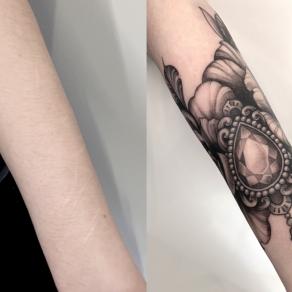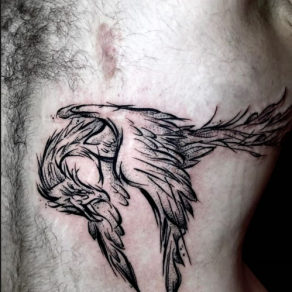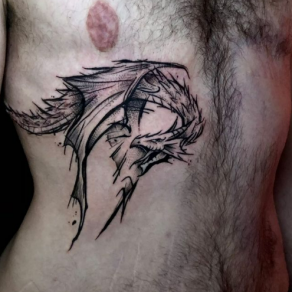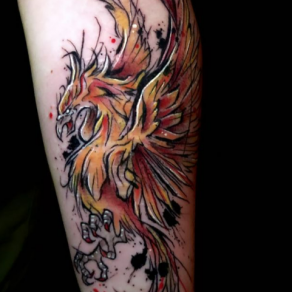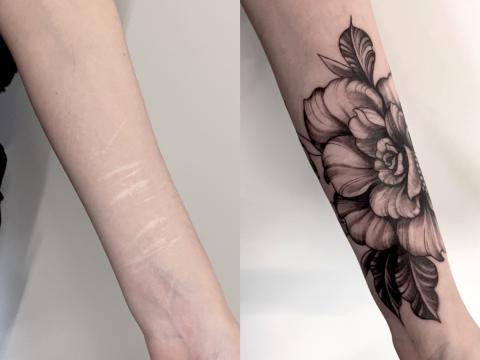
A process of emotional healing, personal expression, or simply the desire for aesthetic camouflage: there are several reasons that can justify the covering of a scar with a tattoo. Types of marks, body areas, styles, precautions: our Parisian studio explains everything you need to know about the topic!
Different types of scars that can be covered by a tattoo
A scar is fibrous tissue that permanently or for a prolonged period replaces normal tissue after an injury. While it's impossible to list all types here, we present the main types of scars for which, on a case-by-case basis, a cover-up tattoo can be considered.
Self-harm
Self-harm refers to the act of inflicting injuries on oneself. Lacerations on the arms, thighs, or other parts of the body can leave lifelong marks; a tattoo can then cover these scarifications.
Burns
A burn is the destruction of the skin by an assault, most often thermal, by contact with a significant heat source: flames, a hot iron, scalding liquid, etc. Depending on the degree and extent of the burn, it can be covered by a tattoo.
Keloid
A keloid refers to a fibrous ridge developed on a scar. Treatments exist to reduce these skin nodules; consulting a dermatologist is strongly recommended before considering a tattoo.
Mastectomy
Also known as mammectomy, mastectomy is the surgical removal of the mammary gland. Primarily performed in the case of breast cancer, it can be total or partial. A cosmetic tattoo can cover the visible scar on the chest, but some practitioners specialize in 3D areola and nipple tattoos.
Cesarean section
A surgical operation that consists of extracting the fetus through an incision in the abdominal wall and uterus when childbirth is impossible through natural means, a cesarean section can leave a visible scar. A tattoo made on the lower belly then helps to conceal it.
Abdominoplasty
In case of excess fat around the waist, some people opt for a tummy tuck. The traces of this abdominoplasty can be faded with a tattoo.
Reconstructive surgery
A broad field of surgery, this specialty includes all interventions aimed at repairing various injuries of the human body. Here too, a tattoo can be considered in various circumstances:
- bedsores
- superficial tumors
- traumas to the limbs
- congenital malformations
- etc.
A concealment possible on all body parts
Covering a scar with a tattoo is a practice that, in theory, can be considered for all parts of the body; you and you alone have the right to decide. However, from our experience, the areas that most commonly undergo this procedure are:
- the stomach: pregnancy, cesarean section, abdominal hysterectomy (an operation to remove the uterus via the abdominal route), appendicitis…
- the chest: breast cancer, breast augmentation or reduction…
- the forearms: scarifications, burns…
Note: regardless of the body area, a tattoo over a scar rarely conceals 100% of your mark. Indeed, depending on the case, the skin itself remains shiny, slightly raised. The main purpose of this practice is less about making this traumatic trace disappear by magic and more about "diverting attention"!
Tattoo styles: a broad range of possibilities
Just as all body parts can be considered, so can styles – again, on a case-by-case basis and depending on the possibilities offered by your scar. When it comes to covering marks, the essential thing for the tattoo artist is to work on the texture.
What is texture in tattooing?
In tattooing, "texture" refers to how a tattoo artist uses patterns, shading, lines, and dots to give the illusion of a certain visual sensation on the skin. Texture then creates the effect of a specific material like leather, fur, metal, wood, etc. It is a key element for adding a sense of realism or three-dimensionality to a tattoo.
"Due to the wide range of textures it offers, the biomechanical style is particularly well-suited to covering burns", explains Pierre-Gilles Romieu. Lola Kaa recommends floral and organic – "leaves or tree trunks, for example", she mentions.
Putting a "period" at the end of a wound
Lola Kaa also talks about pepper shading, a tattooing technique close to dotwork that involves using a series of dots to create shades and gradients. This method gives a "peppered" effect on the skin, hence its name. Instead of creating shadows and gradients with smooth, continuous lines, the artist uses dots to create a visually unique texture and an impression of depth.
The different steps of scar covering with a tattoo
First step? Make sure that your cut, burn, or other mark has healed properly; the act of tattooing must not interrupt this process in any way. Once your skin is healed, here are the main steps that will mark your journey:
- You contact your tattoo artist, usually by email, to present your project. To guide them better, you can send a few reference images, tattoos that you like, and ideally, a photo of the area to be tattooed and the scar to be covered.
- Once the appointment is set, the artist carefully shaves any potential hair or fuzz that covers the area to be tattooed, taking care to respect your scar, and then disinfects the area.
- If you have chosen a stencil tattoo, the artist will overlay the printed tracing paper onto your skin. On the other hand, if you have opted for a freehand tattoo, your tattoo artist will do a preliminary tracing with a marker.
- Everything is ready: your tattoo artist takes out their tattoo machine (dermograph) and starts tattooing you!
- When your session is finished, you apply all the usual tattoo aftercare: cleaning with an antiseptic solution, application of ointment, etc.
- Touch-ups may be necessary after any tattooing act. If this is the case, you return to see your tattoo artist, usually a month after the initial procedure!
Getting a scar covered with a tattoo: pros and cons
Are you hesitating? The main advantage of tattooing over a scar – and the most important one – is that it allows you to reclaim your body. By defining the style of the tattoo, its pattern, its colors, and its dimensions yourself, you encourage yourself to accept your mark and, with it, to turn the page on a traumatic period.
The disadvantage is purely technical: the scar will necessarily dictate the rules in terms of design. In other words, the artist will have more freedom on untouched skin, while they will have to work with the contours and textures of your bodily mark.
Scar tattooing: frequently asked questions
Timing, pain, cost: our tattoo studio answers your most frequent questions on the subject!
When to get tattooed on a scar?
The time it takes for a wound to heal depends on several factors, including:
- The size and depth of the wound
- The person's age
- The overall health condition
- Whether the wound was properly treated
In general, a small cut or superficial scratch can heal in one to two weeks. For a more significant injury, like a deep cut or severe burn, the healing process can take several weeks or even months.
Another important point: remember that even if a wound seems to have healed on the surface, the healing process can still continue underneath. Indeed, once new skin has formed a protective barrier over the wound, the healing process continues internally to repair and strengthen tissues.
So the rule is: consult your dermatologist or general practitioner before getting tattooed!
Does a tattoo on a scar hurt?
The pain felt during a scar tattooing session does not differ from that of standard tattooing sessions: it all depends on the tattooed area (some being more sensitive than others) and the person's sensitivity.
However, note that when a strong scar tissue has formed, the pain during the tattooing may be reduced! Good news, right?
Is there a special care required for a tattoo done on a scar?
A tattoo on a scar requires the same care that you would give to a standard tattoo. For a month, apply an antiseptic solution-cold water-paper towel to your tattoo, as well as a daily tattoo care ointment. Attention: avoid stagnant waters and UV rays!
Does a tattoo on a scar cost more than a standard tattoo?
No: a tattoo on a scar does not cost more than a standard tattoo. The same factors directly influence the quote offered by the artist, starting with the dimensions of the piece and, therefore, the time spent tattooing.
Examples of tattoos over scars
In our gallery below, we invite you to discover some tattoos done over scars by our artists!
Who is available for your scar covering at La Bête Humaine?
Would you like to entrust your project to one of our tattoo artists? Click to access each one's profile and specialties:
And to meet us in person, we are available every day (except Sunday) from 10 am to 7 pm!

